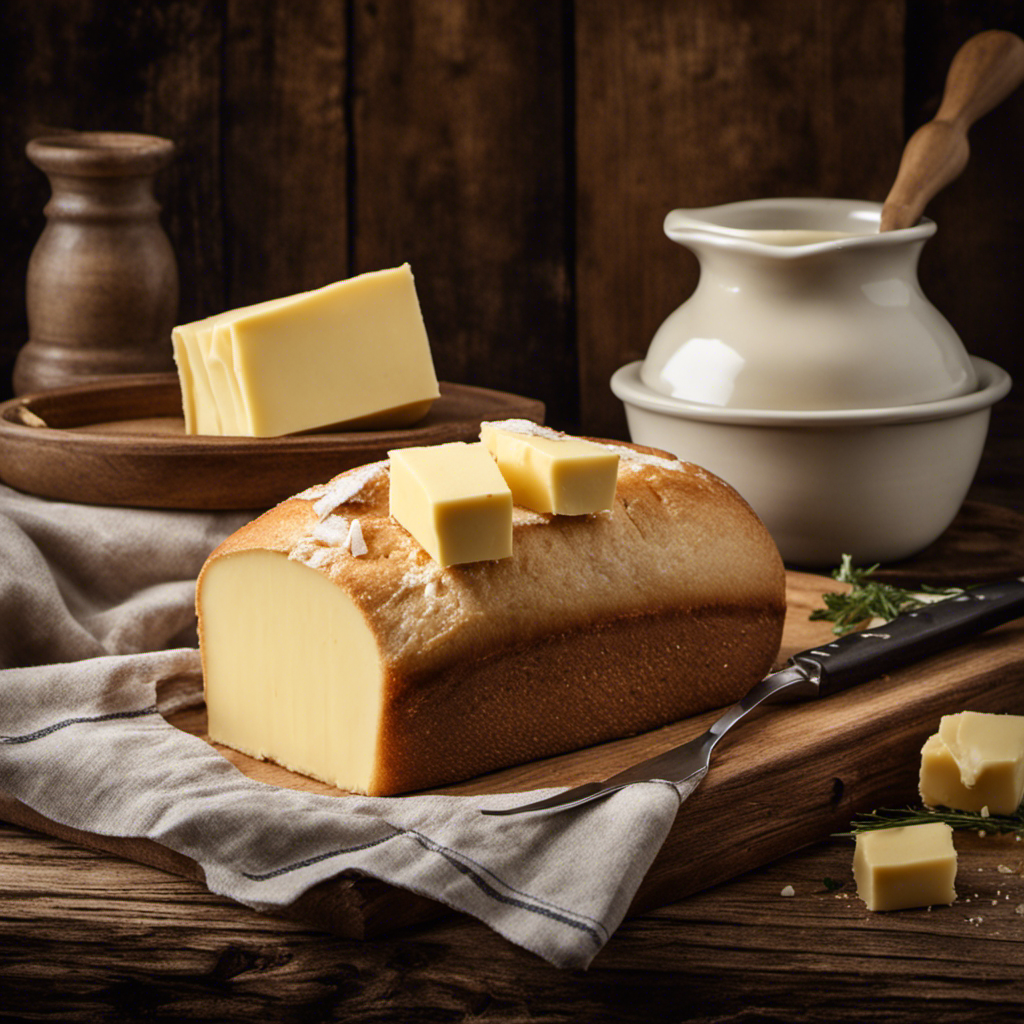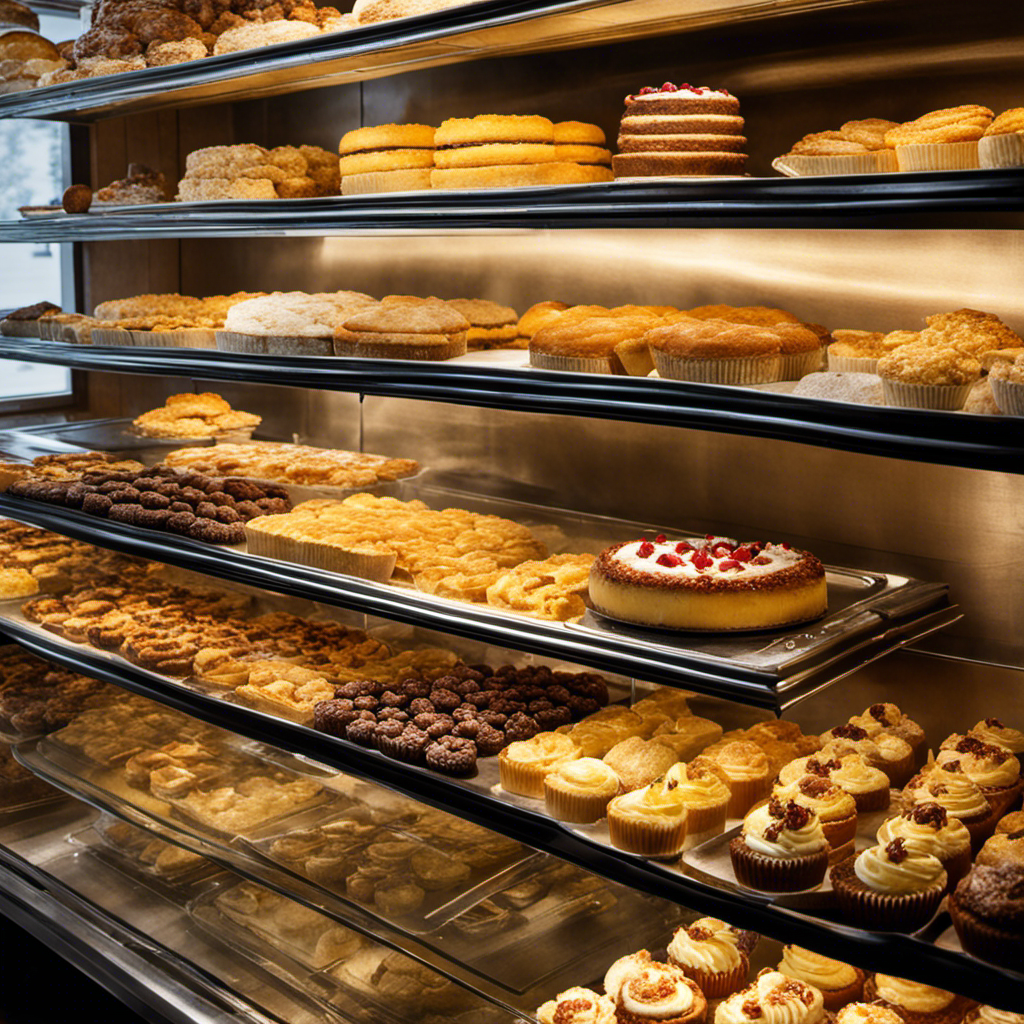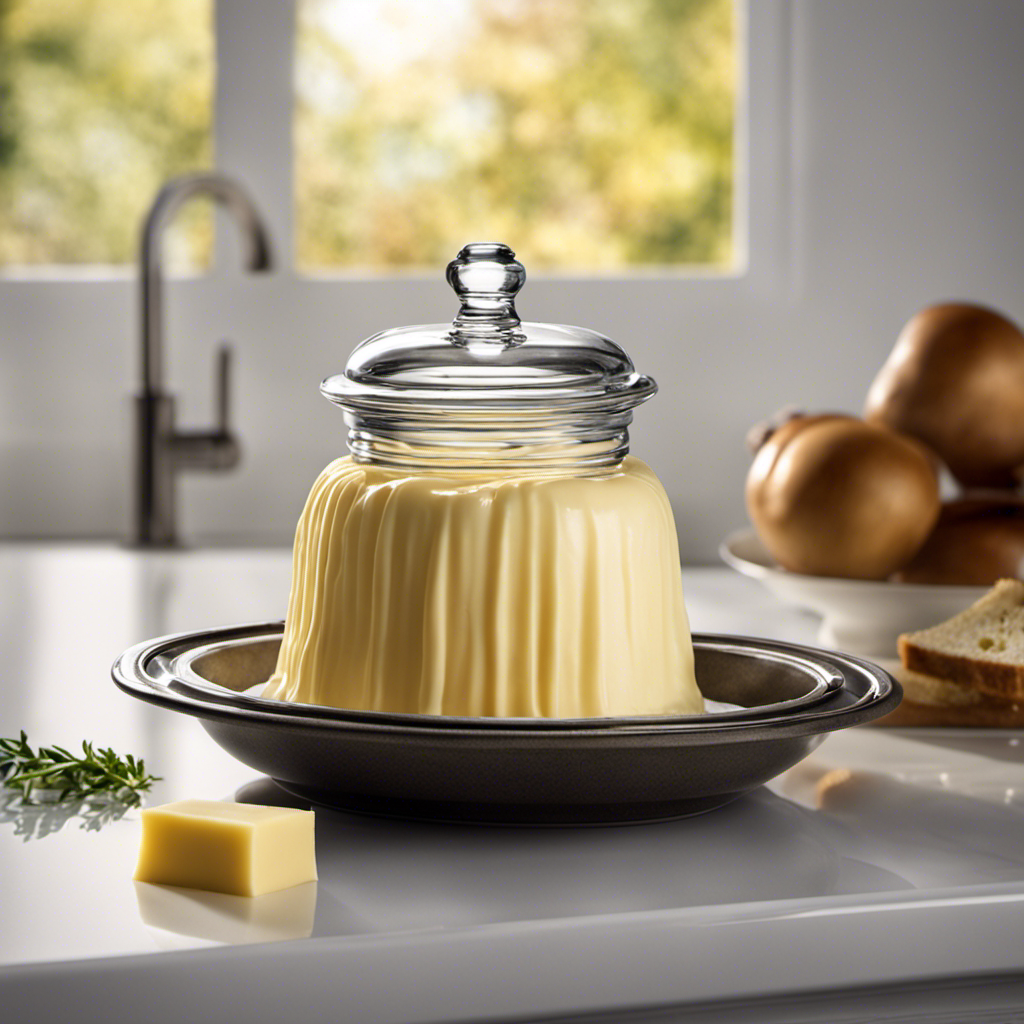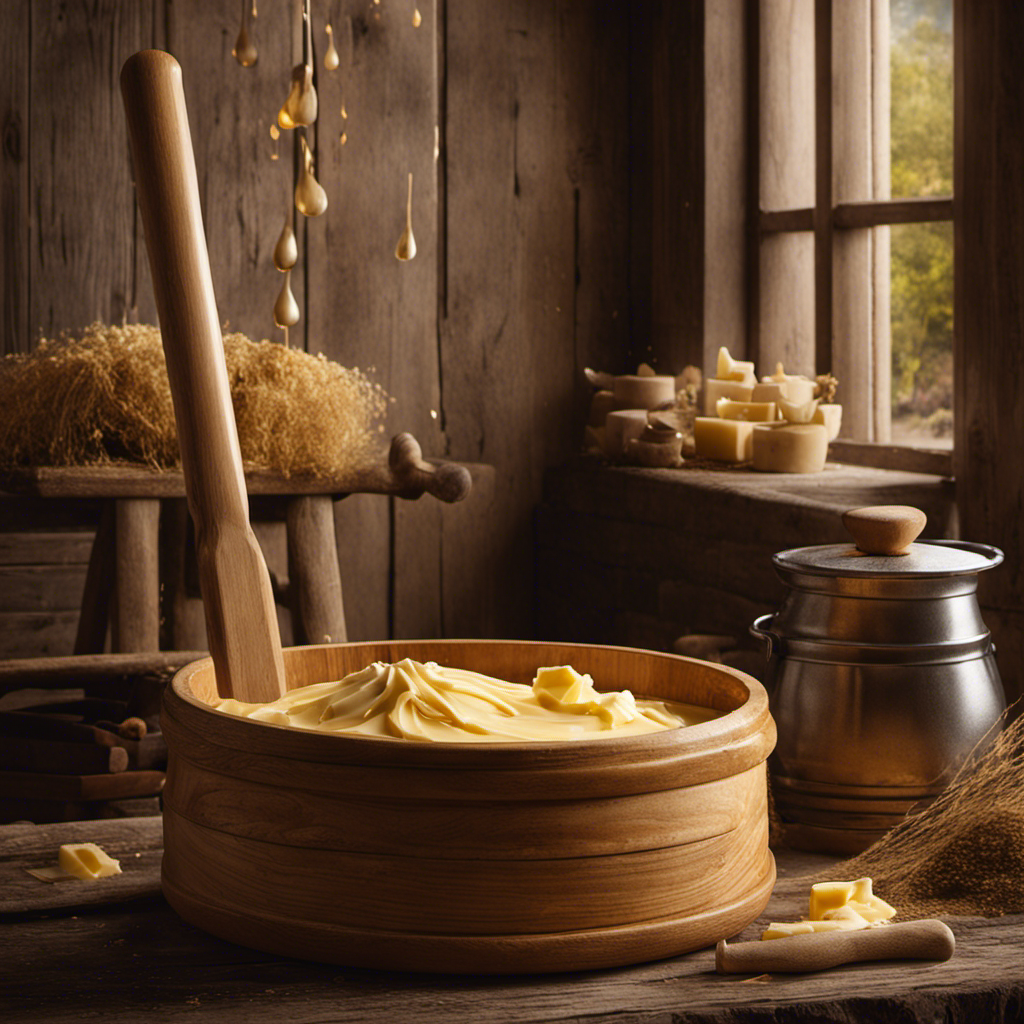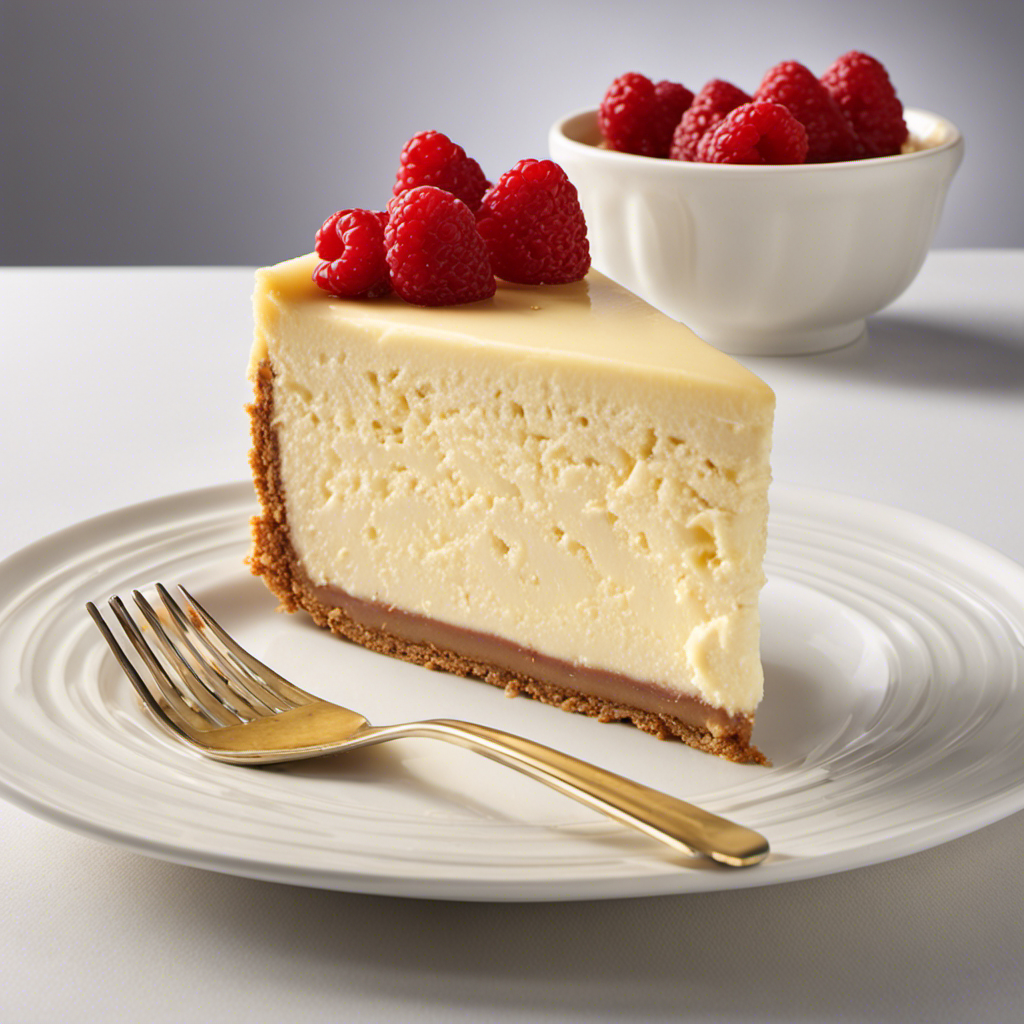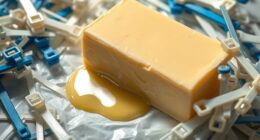As a lover of butter, I have always struggled with keeping it fresh and spreadable. But everything changed when I discovered the amazing invention known as the Butter Bell.
This little contraption has revolutionized my butter game, and today I’m here to share with you the secrets of using the Butter Bell to achieve the perfect butter experience.
From choosing the right Butter Bell to storing and maintaining it, I’ll walk you through every step of the way.
So let’s dive in and unlock the buttery goodness!
Key Takeaways
- Consider the size and design of the Butter Bell that suits your needs.
- Opt for a dishwasher safe and easy to clean Butter Bell.
- Look for a functional and aesthetically pleasing design.
- The Butter Bell keeps butter fresh and at the perfect consistency without the need for refrigeration.
Choosing the Right Butter Bell
When choosing the right butter bell, it’s important to consider the size and design that will best suit your needs.
A butter bell is a simple and effective way to keep your butter fresh and spreadable without refrigeration.
To ensure easy maintenance, opt for a butter bell that is dishwasher safe and easy to clean.
Look for a design that is both functional and aesthetically pleasing, as it will be a stylish addition to your kitchen countertop.
If you’re looking for alternatives to traditional butter bells, consider options like butter dishes with lids or butter keepers.
These alternatives offer similar benefits and can be a great choice if you prefer a different style or design.
Preparing the Butter for the Butter Bell
When it comes to preparing the butter for the butter bell, the first thing to consider is whether to use softened or cold butter. Softened butter is easier to spread, but cold butter can offer a firmer and more refreshing texture.
Finding the proper room temperature for your butter is also crucial, as it affects the consistency and overall spreadability. Achieving the perfect balance between softened and cold butter, along with the ideal room temperature, will ensure a delightful spread for your bread or toast.
Softened Vs Cold Butter
Using softened butter instead of cold butter will make it easier to spread on bread.
When it comes to choosing the right butter dish, there are a few key factors to consider.
Firstly, make sure the dish is large enough to accommodate the entire stick of butter.
Secondly, opt for a dish with a lid to keep the butter fresh and protected from any odors in the fridge.
Lastly, look for a dish that is easy to clean and dishwasher safe for convenience.
The benefits of using softened butter are numerous.
It spreads effortlessly on bread, making every bite more enjoyable.
It also blends seamlessly into recipes, ensuring a smooth and creamy texture.
Transitioning to the next section about proper room temperature, it is crucial to understand the importance of allowing butter to come to room temperature before using it.
Proper Room Temperature
Transitioning to the next section, it’s important to know the ideal room temperature for butter. When it comes to baking and cooking, room temperature butter is a key ingredient. It’s soft, creamy, and blends easily with other ingredients, resulting in a smooth and well-incorporated mixture. But what exactly is the ideal room temperature for butter? Let me break it down for you:
| Temperature Range | Description | Benefits |
|---|---|---|
| 60-65°F | Slightly cool and firm to touch | Perfect for spreading on bread or toast |
| 68-72°F | Soft and pliable | Easily incorporated into recipes |
| 74-78°F | Very soft and spreadable | Ideal for cake batters and frostings |
Using room temperature butter not only helps in achieving better texture and consistency in your culinary creations, but it also enhances the flavor and reduces the amount of time spent on mixing. To keep your butter at the perfect temperature, consider using a butter bell. This handy kitchen tool keeps butter fresh and soft for days, without the need for refrigeration. The benefits of using a butter bell are twofold – you’ll always have room temperature butter on hand, and you’ll enjoy the full flavor of butter without the cold, hard texture.
Consistency for Spreading
To achieve the perfect consistency for spreading, it’s important to keep your butter at room temperature. When butter is too cold, it becomes hard and difficult to spread, resulting in torn bread or unevenly buttered toast. On the other hand, if butter is too warm, it can melt and make a mess.
Here are three tips to ensure the ideal spreading consistency:
-
Store your butter properly: Keep it in an airtight container or a butter bell to protect it from absorbing odors and maintain its freshness.
-
Plan ahead: Take the butter out of the fridge and let it sit at room temperature for about 30 minutes before using. This will allow it to soften without becoming too soft.
-
Test for readiness: Gently press the butter with your finger. If it gives slightly and leaves a small indentation, it’s ready to be spread.
Using the Butter Bell for Fresh and Soft Butter
Get ready to enjoy fresh and soft butter by using the Butter Bell. When it comes to choosing the right container for your butter, look no further than the Butter Bell.
This innovative device is designed to keep your butter at the perfect temperature and consistency. The benefits of using a butter bell are numerous.
First, it keeps your butter fresh for longer periods of time, so you can always have a spreadable, creamy butter on hand. Second, it eliminates the need for refrigeration, allowing you to keep your butter at room temperature without worrying about spoilage.
Storing Butter in the Butter Bell
Storing your butter in the Butter Bell ensures that it stays soft and spreadable. The Butter Bell is a unique butter dish that keeps your butter fresh and ready to use. Here are some reasons why the Butter Bell is the perfect choice for storing your butter:
-
Airtight Seal: The Butter Bell has a specially designed lid that creates an airtight seal, preventing air and moisture from reaching the butter. This helps to maintain its freshness and prevents it from spoiling.
-
Water Bath: The Butter Bell also features a water bath that helps to keep the butter at the perfect temperature for spreading. By adding a small amount of water to the base of the dish, the butter stays soft and easily spreadable.
-
Stylish Design: Not only is the Butter Bell functional, but it also adds a touch of elegance to your kitchen. With its beautiful design and various colors to choose from, it’s a great addition to any home.
While the Butter Bell is a wonderful option for storing butter, there are also alternatives available. Some popular alternatives include using a butter crock or a butter dish with a lid. These options also help to keep the butter fresh and spreadable, but may not have the same airtight seal and water bath feature as the Butter Bell.
Ultimately, the choice depends on your personal preference and needs.
Cleaning and Maintaining the Butter Bell
When it comes to the proper cleaning techniques for the Butter Bell, there are a few key points to keep in mind.
First and foremost, it’s important to use mild dish soap and warm water to clean both the base and the lid of the Butter Bell. This will help to remove any residual butter and ensure a clean and sanitary storage container.
Secondly, the longevity of the Butter Bell can be greatly extended by regularly cleaning and drying it after each use. This will prevent any build-up or residue from forming, which can lead to mold growth and a shorter lifespan for your Butter Bell.
Lastly, to prevent mold growth, it’s crucial to thoroughly dry the Butter Bell before adding fresh butter. Moisture is a breeding ground for mold, so taking the time to ensure the Butter Bell is completely dry will help to keep your butter fresh and free from any unwanted contaminants.
Proper Cleaning Techniques
To ensure your butter bell stays in optimal condition, make sure you regularly clean it using gentle soap and warm water. Cleaning techniques for a butter bell are simple and easy to follow. Here are some maintenance tips to keep your butter bell clean and functional:
- Use a soft sponge or cloth to gently scrub the interior and exterior of the butter bell.
- Rinse thoroughly with warm water to remove any soap residue.
- Dry the butter bell completely before adding fresh butter to prevent any moisture buildup.
Longevity of the Butter Bell
Regular cleaning and proper maintenance helps ensure the butter bell lasts for a long time. But what if you’re looking for alternatives to the traditional butter bell? Well, let me tell you about the benefits of using a butter bell and why it’s worth considering.
First of all, a butter bell keeps your butter fresh and spreadable without refrigeration. It’s a simple yet effective way to store and preserve butter. Plus, it adds a touch of elegance to your dining table.
The butter bell works by keeping the butter submerged in water, creating an airtight seal that prevents spoilage. It’s easy to use and clean, and there are many stylish designs to choose from.
Preventing Mold Growth
Proper cleaning and maintenance are key to preventing mold from growing on your butter bell. Mold can ruin the taste and texture of your butter, so it’s important to take the necessary steps to keep it at bay.
Here are a few tips to help you prevent mold growth and troubleshoot common issues:
-
Clean your butter bell regularly with warm soapy water. Make sure to remove any leftover butter residue to prevent mold from forming.
-
Store your butter bell in a cool and dry place. Avoid placing it in direct sunlight or near a heat source, as this can create a moist environment that promotes mold growth.
-
Check the water level in the base of your butter bell regularly. If you notice any discoloration or a foul smell, empty the water and clean the base thoroughly.
Tips and Tricks for Using the Butter Bell
For best results, it’s important to keep the butter bell at room temperature before using it. This ensures that the butter is soft and spreadable, making it easier to use. However, there are a few other tips and tricks that can help you make the most out of your butter bell. Here are some key maintenance and troubleshooting tips:
| Maintenance Tips | Troubleshooting Tips |
|---|---|
| – Clean the butter bell regularly to prevent buildup of old butter | – If the butter becomes too soft or runny, place it in the refrigerator for a short while to firm it up |
| – Replace the water in the base every two to three days to prevent mold growth | – If the butter starts to develop an off smell or taste, it may be time to replace it |
| – Store the butter bell in a cool and dry place to maintain its freshness | – If the lid becomes loose, tighten it securely to prevent air from entering and spoiling the butter |
| – Use high-quality butter for the best results | – If the butter bell cracks or chips, it’s time to get a new one |
Frequently Asked Questions
How Long Can I Store Butter in the Butter Bell Before It Goes Bad?
I store butter in the butter bell for up to two weeks before it goes bad. To properly store butter in the butter bell and prevent spoilage, make sure to change the water every few days.
Can I Use Margarine or Vegetable Spreads in the Butter Bell?
I don’t recommend using margarine or vegetable spreads in the Butter Bell. It’s designed specifically for butter. As for cleaning frequency, it’s best to clean the Butter Bell every 2-3 days to prevent any buildup.
Can I Use the Butter Bell for Flavored or Herb-Infused Butter?
I love using my Butter Bell for flavored butter recipes. It’s so easy to infuse herbs and spices into the butter, giving it a delicious twist. Plus, the benefits of using a butter bell are amazing!
How Often Should I Clean the Butter Bell?
I clean my Butter Bell every 3-4 days to ensure it stays fresh and free from any residue. It’s important to wash it with warm, soapy water and dry it thoroughly before adding new butter. Regular maintenance keeps it in great condition!
Can I Leave the Butter Bell Out on the Countertop All Day, or Should It Be Refrigerated When Not in Use?
I leave my butter bell out on the countertop all day. It keeps the butter soft and spreadable. However, if you prefer to refrigerate your butter bell when not in use, that’s also an option.
Conclusion
In conclusion, using a butter bell is a simple and elegant way to keep your butter fresh and spreadable. It adds a touch of nostalgic charm to your kitchen, reminiscent of a bygone era.
By choosing the right butter bell, preparing your butter correctly, and using it properly, you can enjoy the perfect spreadable butter every time. Remember to clean and maintain your butter bell regularly for optimal performance.
So go ahead and indulge in the luxury of soft, creamy butter with the help of a butter bell – it’s a timeless treasure for your kitchen!
